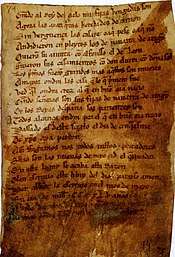Peninsular Spanish
Peninsular Spanish (Spanish: español peninsular), also known as Spanish of Spain (Spanish: español de España), European Spanish (Spanish: español europeo) and Iberian Spanish (Spanish: español ibérico), sometimes referred to as Castilian Spanish, are the varieties of the Spanish language spoken in the Iberian Peninsula, as opposed to the Spanish spoken in the Americas and in the Canary Islands. The related term Castilian Spanish is often applied to formal varieties of Spanish as spoken in Spain.[1][2] According to folk tradition, the "purest" form of Peninsular Spanish is spoken in the Castilian province of Valladolid, although the concept of "pure" language has been questioned by modern linguists.[3][4]

| Spanish language |
|---|
 Spanish around the 13th century |
| Overview |
| History |
|
| Grammar |
| Dialects |
| Dialectology |
| Interlanguages |
| Teaching |
In phonology, the most prominent distinguishing element of Peninsular Spanish varieties, except for the southernmost ones, is the preservation of a distinction between the phonemes /s/ and /θ/, represented respectively with the letters ⟨s⟩ on one hand and ⟨z⟩, or ⟨c⟩ before ⟨e / i⟩, on the other. This is usually called distinción in Spanish, while the lack of distinction between the two is called seseo or ceceo, depending on the phonetic outcome ([s] in the former case, [s̟] in the latter). On one hand, in the Spanish of the Americas and in parts of southern Spain, words spelled with ⟨z⟩, with ⟨c⟩ before ⟨e⟩ or ⟨i⟩, or with ⟨s⟩ are all typically pronounced with a sound similar to the English /s/; on the other hand, in the Peninsular dialects with distinción, words with ⟨z⟩ or with ⟨c⟩ before ⟨e⟩ or ⟨i⟩ are pronounced with [θ]—that is, the initial sound of the English word think. However, many Andalusian dialects and the Spanish spoken in the Canary Islands do not use distinción as a general rule, but rather use either seseo or ceceo.
In morphology, the most notable distinguishing feature of Peninsular Spanish is the use of the pronoun vosotros (along with its oblique form os) and its corresponding verb forms for the second person plural familiar. In virtually all other varieties of Modern Spanish, for the second person plural, the familiar and the formal are merged in ustedes, with its verb forms. Again, the use of vosotros is uncommon in the Canary Islands and only partially introduced in Western Andalusia.
Variants
- Andalusian Spanish
- Canarian Spanish
- Castilian Spanish
- Castrapo (Spanish spoken in Galicia, as opposed to the Galician language)
- Castúo
- Linguistic features of Spanish language spoken by Catalan-speakers
- Murcian Spanish
References
- "Castilian Spanish". ncl.ac.uk. Retrieved 23 May 2015.
- "Castilian". Webcitation.org. Archived from the original on October 31, 2009. Retrieved 2015-08-11.
- MARCOS, JAVIER RODRÍGUEZ (2011-12-15). ""En ningún sitio se habla el mejor español del mundo"". El País (in Spanish). ISSN 1134-6582. Retrieved 2019-04-01.
- "Lingüista sostiene que no hablan mejor español en Valladolid que en Medellín". La Vanguardia (in Spanish). 2016-09-03. Retrieved 2019-04-01.
External links
- Constraint interaction in Spanish /s/-aspiration: three Peninsular varieties, Richard E. Morris
- Coda obstruents and local constraint conjunction in north-central Peninsular Spanish, Richard E. Morris
- (in Spanish) Jergas de habla hispana Spanish dictionary specializing in slang and colloquial expressions, featuring all Spanish-speaking countries.